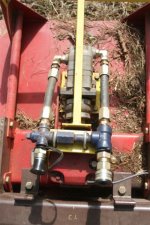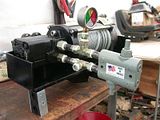J_J
Super Star Member
- Joined
- Sep 6, 2003
- Messages
- 18,928
- Location
- JACKSONVILLE, FL
- Tractor
- Power-Trac 1445, KUBOTA B-9200HST
I know in the neutral position the pump fluid is returned to tank, but what happens to the fluid in a motor circuit. I believe it locks up and goes nowhere. What say you.
I am thinking the relief valve is on the input side, and that would not do anything for the pressure on the other side. You all know that a cylinder, or motor will lock in place when the handle is returned to neutral, blocking the output flow.
Now, on this same circuit, you are turning a hydraulic motor at max, and the handle on the valve is pulled back to neutral. What happens to the fluid in the output circuit, considering the fact that the hyd motor is still spinning with all that inertia. Will the hydraulic motor try and act like a pump. The flow is now blocked, so what happens.
I know one should use a motor spool valve when using a hydraulic motor, which will let the fluid circulate in the neutral position.
Sometimes we think that we understand, but don't. You know, that fuzzy gray area.
I am thinking the relief valve is on the input side, and that would not do anything for the pressure on the other side. You all know that a cylinder, or motor will lock in place when the handle is returned to neutral, blocking the output flow.
Now, on this same circuit, you are turning a hydraulic motor at max, and the handle on the valve is pulled back to neutral. What happens to the fluid in the output circuit, considering the fact that the hyd motor is still spinning with all that inertia. Will the hydraulic motor try and act like a pump. The flow is now blocked, so what happens.
I know one should use a motor spool valve when using a hydraulic motor, which will let the fluid circulate in the neutral position.
Sometimes we think that we understand, but don't. You know, that fuzzy gray area.


